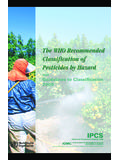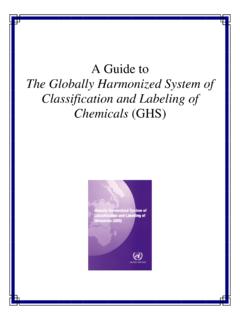Transcription of WHO Library Cataloguing-in-Publication Data
1 WHO Library Cataloguing-in-Publication Data world health organization . The WHO recommended classification of pesticides by hazard and guidelines to classification : 2004. - toxicity - classification substances - classification Programme on Chemical ISBN 92 4 154663 8 (NLM classification : WA 240) ISSN 1684-1042 world health organization 2005 All rights reserved. Publications of the world health organization can be obtained from Marketing and Dissemination, world health organization , 20 Avenue Appia, 1211 Geneva 27, Switzerland (tel: +41 22 791 2476; fax: +41 22 791 4857; email: Requests for permission to reproduce or translate WHO publications whether for sale or for noncommercial distribution should be addressed to Marketing and Dissemination, at the above address (fax: +41 22 791 4806.))
2 Email: The designations employed and the presentation of the material in this publication do not imply the expression of any opinion whatsoever on the part of the world health organization concerning the legal status of any country, territory, city or area or of its authorities, or concerning the delimitation of its frontiers or boundaries. Dotted lines on maps represent approximate border lines for which there may not yet be full agreement. The mention of specific companies or of certain manufacturers products does not imply that they are endorsed or recommended by the world health organization in preference to others of a similar nature that are not mentioned. Errors and omissions excepted, the names of proprietary products are distinguished by initial capital letters.
3 All reasonable precautions have been taken by WHO to verify the information contained in this publication. However, the published material is being distributed without warranty of any kind, either express or implied. The responsibility for the interpretation and use of the material lies with the reader. In no event shall the world health organization be liable for damages arising from its use. Cover design: J-C. Fattier, Graphic Design and Layout, WHO. 1 THE WHO recommended classification OF pesticides BY HAZARD AND GUIDELINES TO classification 2004 The WHO recommended classification of pesticides by Hazard was approved by the 28th world health Assembly in 1975 and has since gained wide acceptance.
4 When it was published in the WHO Chronicle, 29, 397-401 (1975), an annex, which was not part of the classification , illustrated its use by listing examples of classification of some pesticidal active ingredients and their formulations. Later suggestions were made by Member States and pesticide registration authorities that further guidance should be given on the classification of individual pesticides . Guidelines were first issued in 1978, and have since been revised and reissued at 2-3-year intervals. As has been the case for previous editions of the classification , this edition complies with the original guidelines approved in the world health Assembly 1975.
5 In December, 2002 the United Nations Committee on Experts on the Transport of Dangerous Goods and on the Globally Harmonized System of classification and Labelling of Chemicals (UNCETDG/GHS) approved a document called "The Globally Harmonized System of classification and Labelling of Chemicals" with the intent to provide a globally-harmonized system to address classification of chemicals, labels, and safety data sheets. classification and labelling based on acute toxicity form a part of the GHS, and there are some differences between the GHS and the WHO traditional classification of pesticides by hazard.
6 WHO is in the process of adjusting the Pesticide classification to conform to the GHS; the results of this process are expected to be available in the next edition of the classification , to be published within the next two years. The document is arranged as follows: Part I: The classification as recommended by the world health Assembly. This part is not subject to periodic review and the classification table and text can only be changed by resolution of the world health Assembly. Part II: Guidelines to classification . Individual products are classified in a series of tables, according to the oral or dermal toxicity of the technical product, and its physical state.
7 The tables are subject to review periodically. The toxicity values are intended to be a guide only. Formulations should be separately classified using the methods set out on pages 3 (single technical product) and 6 (mixtures) and the table in Part I. To assist in the classification of formulations, an annex is now provided giving numerical tables from which the classification may also be derived. Comments on Part II of the document are welcome, together with proposals for new entries. These should be addressed to the International Programme on Chemical Safety, world health organization , 1211 Geneva 27, Switzerland, and should include supporting data on the compound being commented on or proposed.
8 This document is a revision of the document previously issued as ISBN 92 4 154564 X. 2 PART I recommended classification OF pesticides BY HAZARD Extract from WHO Chronicle, 29: 397-401 (1975) In 1973, the WHO Executive Board asked the Director-General of WHO to take steps to develop a tentative classification of pesticides that would distinguishbetween the more and the less hazardous forms of each pesticide. A proposal for a WHO recommended classification of pesticides by hazard was accordinglyprepared, taking into account the views of members of the WHO Expert AdvisoryPanel on Insecticides and other expert advisory panels with special competence and interest in pesticide technology, as well as the comments of WHO Member Statesand of two international agencies.
9 This proposal was adopted by the Twenty-eighth world health Assembly, which recommended the use of the classification byMember States, international agencies, and regional bodies. The hazard referred to in this Recommendation is the acute risk to health (that is, the risk of single or multiple exposures over a relatively short period of time) that might be encountered accidentally by any person handling the product in accordance with the directions for handling by the manufacturer or in accordance with the rules laid down for storage and transportation by competent international bodies. Any classification based on biological data can never be treated as final.
10 In the assessment of biological data, honest differences of opinion are inevitable and most borderline cases can be reclassified in an adjacent class. Variability or inconsistency in toxicity data due to differences in susceptibility of test animals, or to experimental techniques and materials used can also result in differing assessments. The classification criteria are guide-points intended to supplement but never to substitute for special knowledge, sound clinical judgement or experience with a compound. Reappraisal might be necessary from time to time. Basis of classification The classification distinguishes between the more and the less hazardous forms of each pesticide in that it is based on the toxicity of the technical compound and on its formulations.
















